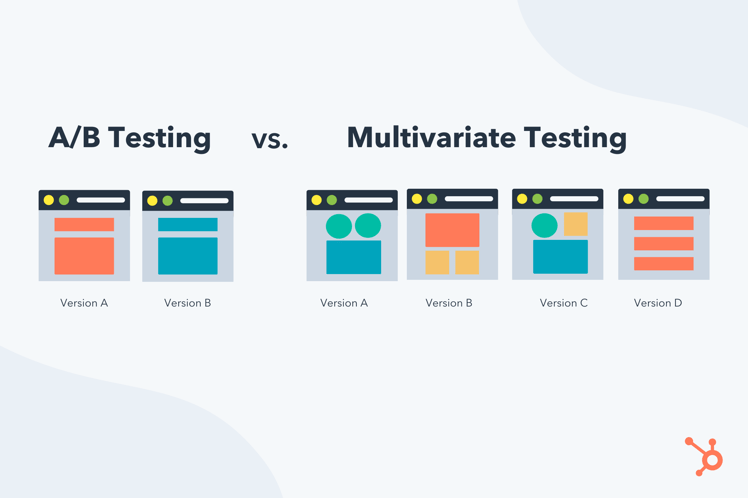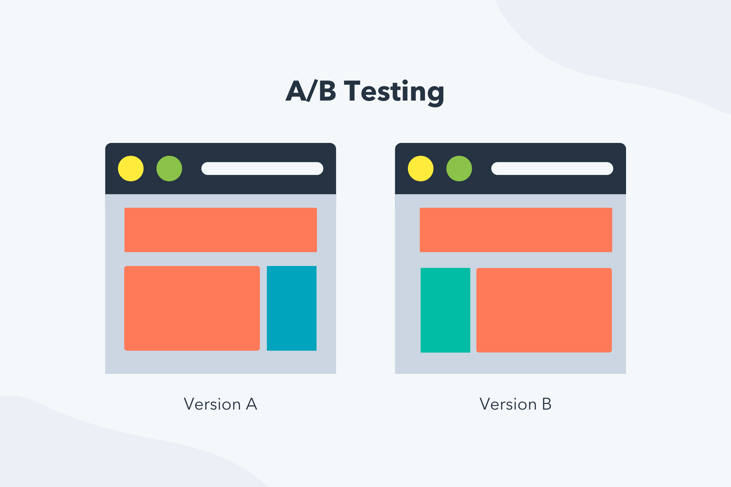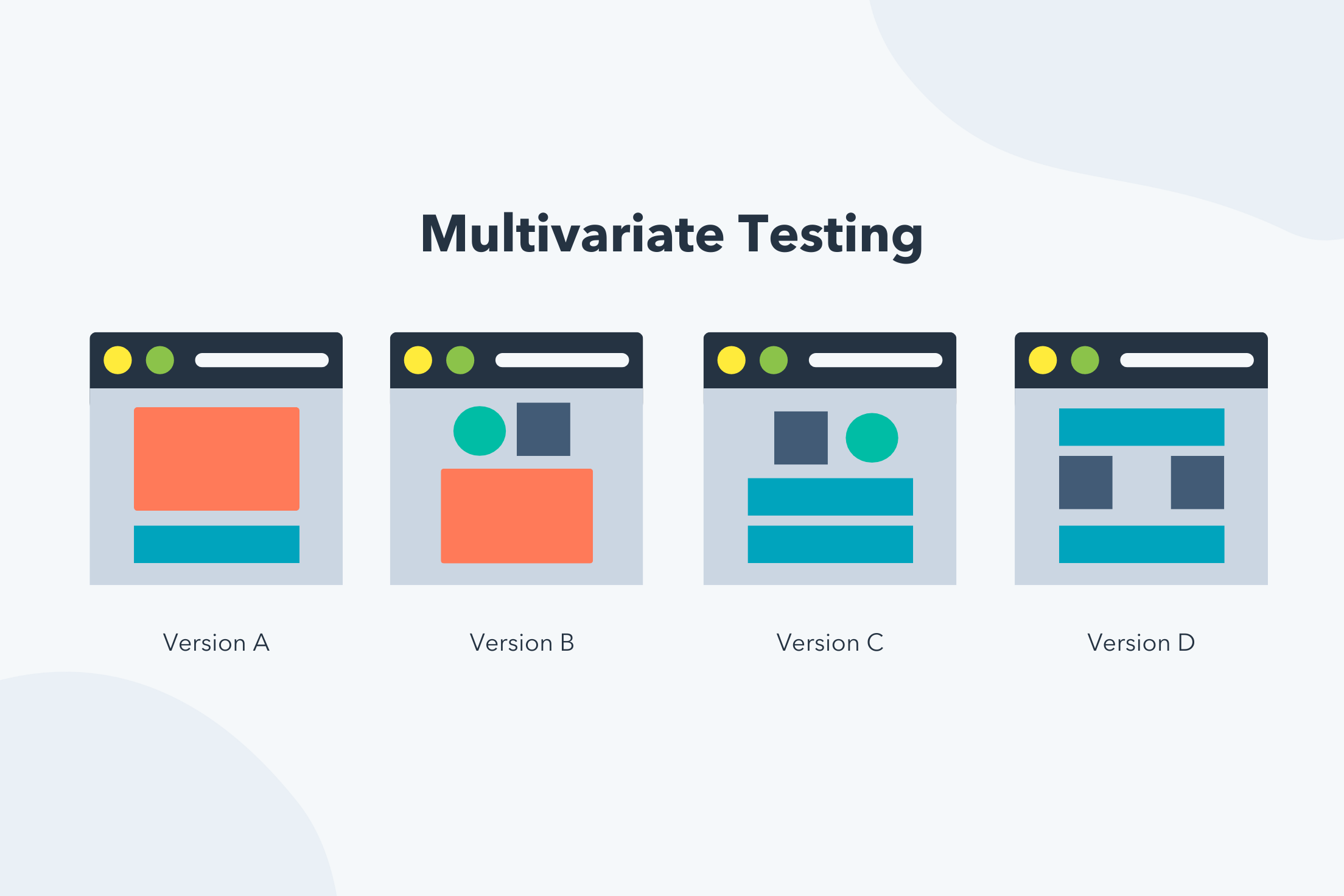There’s seemingly no end to what you can test in your marketing — conversion rates, offer placements, and even which titles perform better.
There’s also no end to the type of test you can run, but two players take center stage: A/B and multivariate testing. Is there a huge difference between them, though? And will my results be affected if I choose the wrong one?
Yes, there is a difference, and yes, your results will be affected. Not to fear, though; in this post, we’re going to break down the difference between A/B tests and multivariate tests and tell you exactly when to use each, so your tests run smoothly and your inbound marketing can go from working pretty well to amazingly well.
The critical difference is that A/B testing focuses on two variables, while multivariate is 2+ variables. As the difference between both tests can be seen visually, let’s go over an example.
Multivariate vs. A/B Testing Example

In the image above, the A/B test is simply two different versions of the same with minute changes, while the multivariate test looks at multiple different page elements (variables) in different positions on the page.
Given their differences, let’s learn more about each one and when to leverage each test in your marketing.
What Is an A/B Test?
When you perform an A/B test , you create two different versions of a web page, and split the traffic evenly to see which performs better. The image below is an example of an A/B test.

A/B testing is often done with two different variables, but there are A/B/C tests that test three different web page versions, an A/B/C/D test that tests four different web page versions, and well, you get the picture. In an A/B test, you can change any variable you want from page to page, and it is a testing best practiceto create two different pages for your test.
When to Use A/B Testing
Use A/B testing when you want to test two specific designs against each other, and you want meaningful results fast. It is also the correct method to choose if you don’t have a ton of traffic to your site as you’re only testing two variables, so significant data is not needed.
Advantages and Limitations of A/B Testing
| Advantages of a/b testing | limitations of a/b testing |
| Fewer variables so data is easier to track, and you can get a true sense of what works and what doesn’t. | The focus is on two single variables, so test results are hyper-focused and not generalizable. |
| You can obtain results quickly |
When you perform a multivariate test, you’re not simply testing a different version of a web page like you are with an A/B test. With this process, you’ll get an idea of which elements on a page play the most significant role in achieving a page’s objective.
The multivariate test is more complicated and best suited for more advanced marketing testers, as it tests multiple variables and how they interact with one another, giving far more possible combinations for the site visitor to experience.
When to Use Multivariate Testing
Only use a multivariate test if you have a significant amount of website traffic. If you do have a lot of site traffic, the following use case is if you have pages that contain several different elements, and you want to understand what would happen if you made significant changes to the features on the page, like their placement.
Advantages and Limitations of Multivariate Testing
| advantages of multivariate testing | limitations of multivariate testing |
| It helps you redesign site pages to have the most impact. | Requires significant site traffic since you need enough data to test all variables accurately, and not all businesses have this traffic. |
| Results are significant because multivariate testing requires considerable website traffic. | Is a rather advanced and involved marketing process. |
| You can extrapolate results because multiple variables are being tested, and you have significant data points. |
This is a tricky concept, and a visual usually helps clarify complicated ideas. The image below is an example of a multivariate test.

Just remember that for multivariate and A/B tests to give meaningful results, it's not enough to have site traffic overall — the pages you’re testing also need to receive substantial traffic! So make sure you select pages that people can find and regularly visit so your test yields some data to analyze.
from Marketing https://blog.hubspot.com/blog/tabid/6307/bid/30556/the-critical-difference-between-a-b-and-multivariate-tests.aspx
There’s seemingly no end to what you can test in your marketing — conversion rates, offer placements, and even which titles perform better.
There’s also no end to the type of test you can run, but two players take center stage: A/B and multivariate testing. Is there a huge difference between them, though? And will my results be affected if I choose the wrong one?
Yes, there is a difference, and yes, your results will be affected. Not to fear, though; in this post, we’re going to break down the difference between A/B tests and multivariate tests and tell you exactly when to use each, so your tests run smoothly and your inbound marketing can go from working pretty well to amazingly well.
The critical difference is that A/B testing focuses on two variables, while multivariate is 2+ variables. As the difference between both tests can be seen visually, let’s go over an example.
Multivariate vs. A/B Testing Example

In the image above, the A/B test is simply two different versions of the same with minute changes, while the multivariate test looks at multiple different page elements (variables) in different positions on the page.
Given their differences, let’s learn more about each one and when to leverage each test in your marketing.
What Is an A/B Test?
When you perform an A/B test , you create two different versions of a web page, and split the traffic evenly to see which performs better. The image below is an example of an A/B test.

A/B testing is often done with two different variables, but there are A/B/C tests that test three different web page versions, an A/B/C/D test that tests four different web page versions, and well, you get the picture. In an A/B test, you can change any variable you want from page to page, and it is a testing best practiceto create two different pages for your test.
When to Use A/B Testing
Use A/B testing when you want to test two specific designs against each other, and you want meaningful results fast. It is also the correct method to choose if you don’t have a ton of traffic to your site as you’re only testing two variables, so significant data is not needed.
Advantages and Limitations of A/B Testing
| Advantages of a/b testing | limitations of a/b testing |
| Fewer variables so data is easier to track, and you can get a true sense of what works and what doesn’t. | The focus is on two single variables, so test results are hyper-focused and not generalizable. |
| You can obtain results quickly |
When you perform a multivariate test, you’re not simply testing a different version of a web page like you are with an A/B test. With this process, you’ll get an idea of which elements on a page play the most significant role in achieving a page’s objective.
The multivariate test is more complicated and best suited for more advanced marketing testers, as it tests multiple variables and how they interact with one another, giving far more possible combinations for the site visitor to experience.
When to Use Multivariate Testing
Only use a multivariate test if you have a significant amount of website traffic. If you do have a lot of site traffic, the following use case is if you have pages that contain several different elements, and you want to understand what would happen if you made significant changes to the features on the page, like their placement.
Advantages and Limitations of Multivariate Testing
| advantages of multivariate testing | limitations of multivariate testing |
| It helps you redesign site pages to have the most impact. | Requires significant site traffic since you need enough data to test all variables accurately, and not all businesses have this traffic. |
| Results are significant because multivariate testing requires considerable website traffic. | Is a rather advanced and involved marketing process. |
| You can extrapolate results because multiple variables are being tested, and you have significant data points. |
This is a tricky concept, and a visual usually helps clarify complicated ideas. The image below is an example of a multivariate test.

Just remember that for multivariate and A/B tests to give meaningful results, it's not enough to have site traffic overall — the pages you’re testing also need to receive substantial traffic! So make sure you select pages that people can find and regularly visit so your test yields some data to analyze.


No hay comentarios:
Publicar un comentario